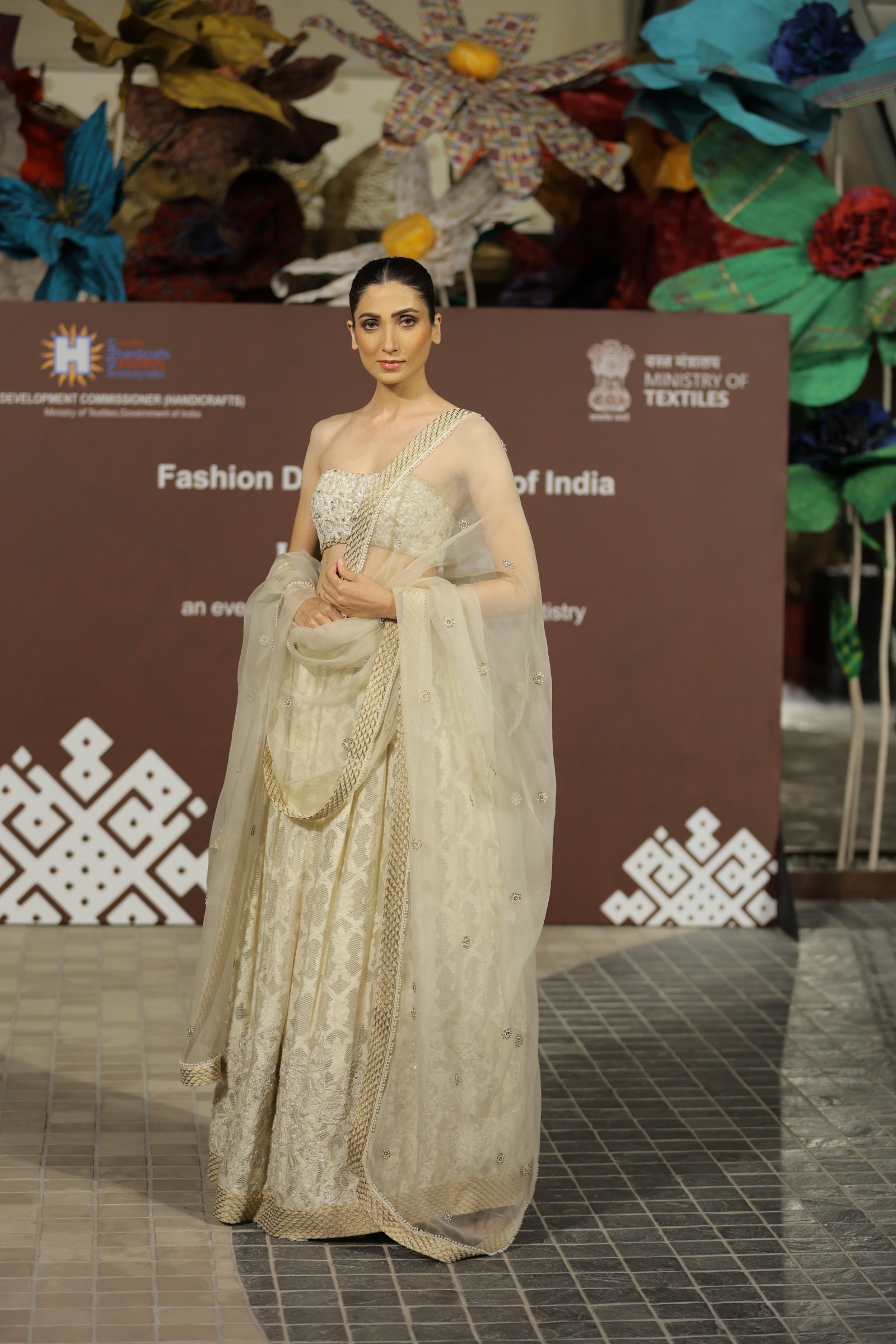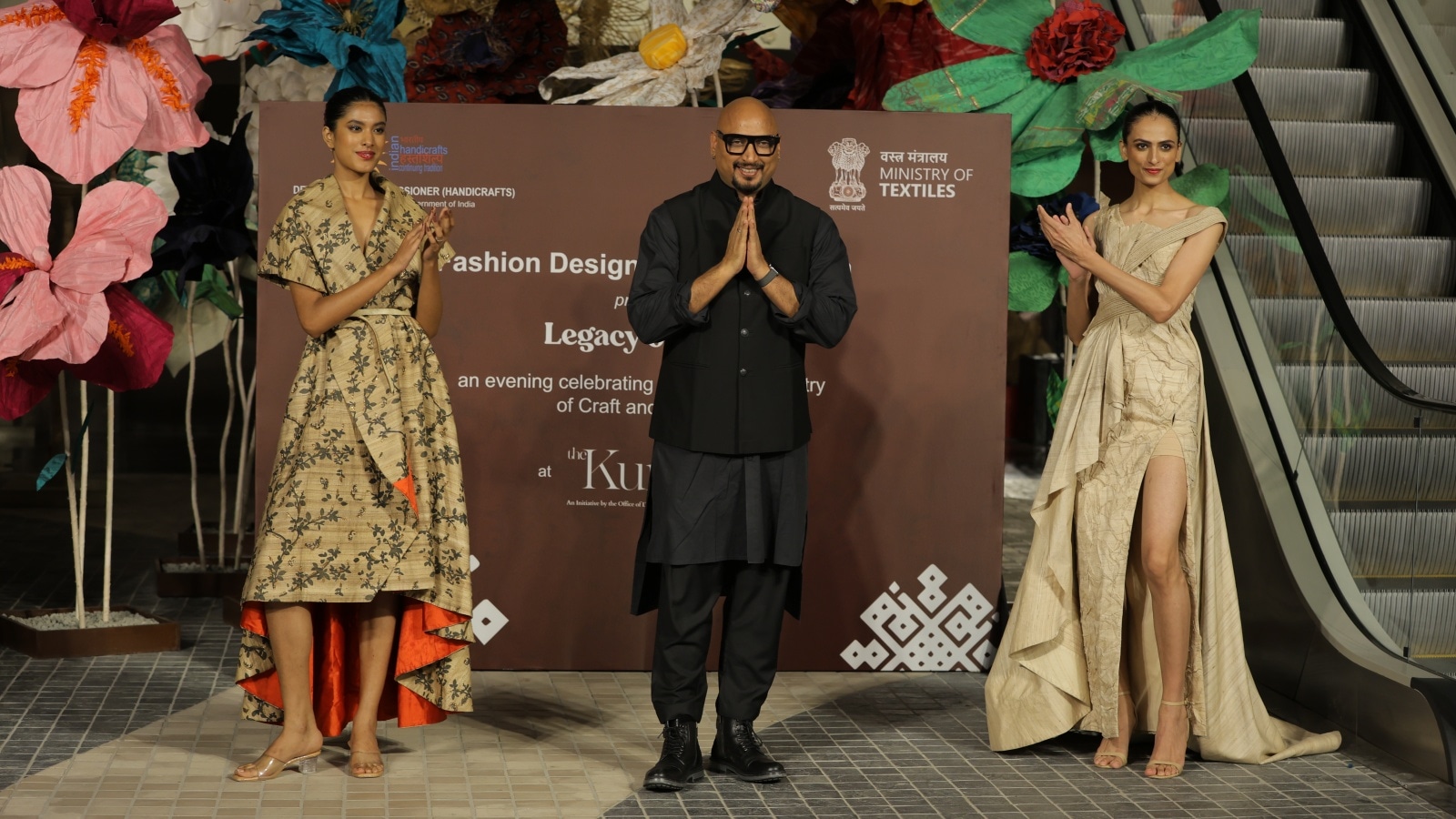The Kunj becomes a fashion hotspot: Top designers reinterpret tradition
An interesting concept from the fashion perspective was the presence of tailors at each weaver collective store
 Fashion designers Samanat Chauhan, Divyam Mehta, Payal Jain, Suket Dhir and Upavita with FDCI chairman Sunil Sethi (Source: File)
Fashion designers Samanat Chauhan, Divyam Mehta, Payal Jain, Suket Dhir and Upavita with FDCI chairman Sunil Sethi (Source: File)Designer Samant Chauhan, who has revived Bhagalpuri silk and combined it with Japanese style minimalism for daywear and saris, recently introduced fitted jackets and wrap dresses. Sometimes self-embossed, sometimes embroidered, the subtle sari jacket is a prime pick for the cocktail season, the contrasting red underlining giving it a luxurious sheen and bounce. It embodied “made in India” for the world.
“Sari is my favourite silhouette because it is casual and elegant and its swish makes for a statement. That’s why I showcased Bhagalpuri silks in various tones and even played with the same tone in a garment, separating them with textures and prints,” says Chauhan, who was part of a fashion showcase of Indian weaves and craft at The Kunj, New Delhi’s newly inaugurated cultural destination dedicated to celebrating India’s artisanal heritage. Called the “Legacy of Crafts”, the show was curated by the Fashion Design Council of India (FDCI) for the Development Commissioner (Handicrafts), Ministry of Textiles.
 The chikankari gown by Payal Jain (Source: File)
The chikankari gown by Payal Jain (Source: File)
While Chauhan played with pure silks, Divyam Mehta’s black collection blended Kantha embroidery, shibori and block printing with some innovation, all of which were done by master craftsmen that The Kunj is providing a platform for. “Unlike the Crafts Museum, which is more an archival documenting of traditions, the master craftsmen at the Kunj are contemporising designs, carrying them forward, making them functional rather than just ceremonial, breaking all cliches and retailing them directly to the consumer. The traditional Sujni embroidered sari can now have abstract, post-modern designs. The Bhadohi carpet can have European designs,” says Anuradha Kumra, advisory board member for retail and craft at the Ministry of Textiles.
Designer Payal Jain chose contrasting black and white palettes and had master craftsmen do the finest chikankari on silks, chiffons and organzas, which she reinterpreted as layered lehengas, tunics and shararas. “These embroideries took months to be finished. I have just used a touch of pearls, crystals and lace,” says Jain. Designer Upavita used white Chanderi as a canvas for summer dresses and gowns, all of them block-printed with floral motifs. She used smart headwraps, which are expected to be an accessory idea across ages.
In fact, the fashion showcase, which was held in the atrium under Ankon Mitra’s sari installation with wraparound retail stores, makes a case for more weaver-led shows here. Mitra’s installation itself is a canopy made out of hundreds of sarees from weaver clusters all over India.
If it’s about home makeovers and refreshing interiors, then the Karigar Sangam could be a reason for reviving the ethnic revolution of the ’80s. It houses over 100 masterpieces created by national awardees, shilp gurus and master artisans. “Each piece here not only has the craftsperson’s name but carries a bit of the history of the artform,” says Kumra.
 Samant Chauhan with his creations (Source: File)
Samant Chauhan with his creations (Source: File)
FDCI chairman Sunil Sethi said spotlighting India’s artisanal legacy was just not enough without a conscious market push. “I was delighted to see buyers picking up goods from each outlet. India’s craft economy is massive yet often undervalued. And we hope to change that by marrying all forms of creativity here. It is an experiential platform and is intended to improve accessibility to our crafts,” he said.
The handicrafts market in India is projected to reach US$ 7,817.8 million by 2032, according to market research firm IMARC’s forecasts. Amrit Raj, Development Commissioner (Handicrafts), Ministry of Textiles, emphasised that The Kunj puts the weaver front and centre of the global luxury market. “Though this has government backing, the idea is to enable weavers to market their wares directly and improve their livelihoods. We will be doing more curated exhibitions, rotate retail spaces and have live demonstrations. If you ask me to sum up in one line, the punchline for this platform would be “hand-made in India, crafted for the world.” Even traditional craftspersons are now creating miniatures for the affordable segment.
An interesting concept from the fashion perspective was the presence of tailors at each weaver collective store. Yes, they can customise your sari and repurpose the textile into any garment that you would want. You could become your own designer.
- 01
- 02
- 03
- 04
- 05































